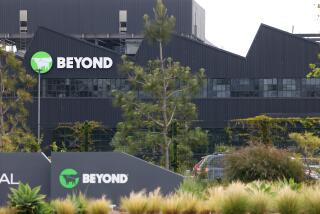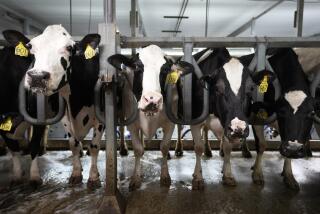To the French, Beef Scare Is Just One More Encroachment on the Gallic Soul
- Share via
ORLEANS, France — If there is a Gallic version of hell, it surely must be this: to watch as food you love is outlawed or deemed dangerous, and to hear that eating it may lead to sickness and death.
Last week, Philippe Bardau, the top-rated chef in this former royal capital on the Loire, took all beef-based dishes off the menu of his 19-table restaurant, which boasts a star in the Michelin guide. No one, Bardau said, dares order his Bavarian beef tenderloin or veal cutlet garnished with veal sweetbread ravioli anymore.
“All this really makes me sorry,” the rotund 38-year-old chef said as he sat in the dining room sipping espresso. “Small cattle farmers are getting hit in the head by all this, and some are going to die.”
Up the street from the restaurant, Christiane Rose was shopping at the Chatelet market for the makings of dinner. “I will no longer buy beef brains or things like that,” the 45-year-old office worker said. “No more organs, either--I’m waiting a bit. I’ve also reduced the amount of beef I eat, but, well, from time to time I buy some anyway.”
A veritable food fright has taken hold in France and other European Union nations. The main cause is an ailment in cattle, bovine spongiform encephalopathy, or BSE--popularly known as “mad cow” disease--that scientists believe causes a similarly brain-addling and ultimately fatal condition in humans.
In France, two people have died from the human form of BSE, “new variant” Creutzfeldt-Jakob disease. In all the EU countries, a spokesman for the trade bloc said last week, there have been 89 people infected, 77 of whom have died.
This year, from Ireland to Germany, 1,563 cases of BSE have been detected in European cattle, and consumers across the region have become increasingly alarmed. In recent weeks, beef sales in the 15-nation EU have plummeted 40%, according to the group’s executive arm, the European Commission.
For the EU, which took action last week to calm fears and shore up the sagging beef industry, mad cow disease arguably has become the bloc’s most urgent problem, at least in the eyes of millions of jittery Europeans. At EU headquarters in Brussels, Associated Press reported, a sign has been taped on the restaurant door to reassure staff that all the beef served there is from Argentina.
Nowhere is the phobia over red meat or other suspect foods as acute as in France, where 125 instances of BSE have been detected this year. This is a nation, after all, where the equation “cuisine equals civilization” has served as justification for a supreme certainty about the rightful place of France in the world.
Until recently, McDonald’s was the most popular target for vilification as the intruder responsible for what people contemptuously term la malbouffe--roughly, “disgusting food.” For many French, the chief threats to wholesome, delicious food were invaders from the United States, including beef from hormone-fed cattle and genetically engineered crops such as corn and soybeans.
But the BSE crisis, and a succession of highly publicized product recalls and hygiene scandals, has shaken the confidence of the French in their own agribusiness sector, which is second only to that of the U.S. as an exporter of food. In the Dordogne region in southwestern France, 23 tons of rotten duck meat were seized by inspectors. In the southwestern town of Castelnaudary, a producer recalled 2 tons of merguez, a beef- and lamb-based sausage, after detecting strains of listeria, a potentially deadly bacteria.
One leading manufacturer of Camembert, the hockey-puck-shaped cheese that is France’s most popular, was exposed by a Paris newspaper this autumn for diluting with water the whole milk it uses. Last year, it was revealed that some French farmers were purchasing processed human waste from water-treatment plants to feed their pigs, fish and poultry.
As worries over BSE mount, andouillette sausages that use bovine intestines for casing, veal sweetbreads (the thymus glands of calves, often served in puff pastry with sauce) and T-bone steaks have been banned in France. In many towns, jumpy mayors have imposed bans on beef in school cafeterias.
For a nation already decidedly wary about the accelerating processes of change, from the Internet to flextime work schedules, these are fresh reasons to worry about forfeiting part of the French soul.
“Today in France, we’re not eating as well as we used to,” said Lydie Livnat, 55. “It’s too artificial. Even in restaurants, I don’t eat meat anymore. . . . Already, we all were dying of cancer, so why make things worse?
“I’m not afraid of dying, no,” the well-tailored Parisian said. “But I don’t want to be poisoned.”
La malbouffe, the French have been discovering with a shock, can be French as well.
Week after week, news of food problems has vied for headlines with reports on the U.S. presidential election, French political scandals and Middle East unrest. When one brand of creamy goat cheese was pulled from two supermarkets in Orleans on Nov. 30 for possible listeria contamination, the local newspaper put the story on Page 1.
No one has been hurt more than the men and women who earn a living raising or selling beef, the chief ingredient in countless French culinary specialties, from beef bourguignon, a savory stew of beef, red wine and onions, to the bistro blue-plate standard of steak and fries. In the heartland city of Clermont-Ferrand, thousands who raise beef gathered Tuesday to protest the declines in the demand and prices for their product and to insist on more government aid.
At Orleans Viandes, a slaughterhouse here that supplies customers as far away as Paris, 70 miles to the north, workers used to butcher 200 cows a week on average. The number has dropped to 100, director Gerard Cladiere said.
“People are lost, people are perplexed,” Cladiere said. “There is all this information, all these headlines, and people don’t understand.”
Export markets collapsed after Italy and Spain decreed a ban on imports of French beef, a measure technically illegal under the EU’s borderless trading rules. At the Italian frontier, farmers have stopped French refrigerator trucks from entering.
There is no evidence, French authorities and professionals in the beef trade insist, that BSE can be transmitted to humans through meat, which is muscle tissue and fat, or through milk. The spinal cord of the animal, believed to be the means of transmission, now must be removed by law at the slaughterhouse. That’s yet another delicacy gone: known as amourette, the rubbery white spinal cord of calves, served pan-fried, is thought by some to enhance one’s lovemaking powers.
Lionel Jospin, France’s Socialist prime minister, traveled here last month and munched beef kebabs before television cameras. “The meat we eat is not only wholesome, it’s excellent,” Jospin said. But many consumers weren’t swayed.
Cladiere, in fact, accuses Jospin and center-right President Jacques Chirac of aggravating a national food “psychosis” through public pronouncements. Chirac even went live on TV earlier last month to demand that Jospin and his ministers take urgent measures to deal with BSE. The gambit, probably taken to score points against his rival, only made the public more suspicious.
For French politicians, mad cow disease and the other food scares could have fateful consequences. In neighboring Belgium, a scandal last year over the use of dioxin-contaminated feed for chickens led to consumer panic, followed by outrage at an official cover-up and an election that threw out the government.
Many in France also recall a 1980s scandal in which the government allowed the use of blood in transfusions despite possible contamination with the AIDS virus. More than 3,700 people, including 1,300 hemophiliacs, became HIV-positive as a result, and hundreds have since died. Three former government ministers were put on trial. One was found guilty, though he received no prison sentence.
The affair had two consequences: It heightened French wariness of politicians, but it also made officials more eager to take action to safeguard public health, even on the basis of sketchy or contradictory information.
Last month, Jospin announced a seven-point plan to protect the health of livestock and people. Most significant, he imposed a moratorium on the use of feed enriched with bone marrow, offal and other slaughterhouse waste.
Such fodder is thought to be the origin of the mid-1980s outbreak of mad cow disease in Britain. The malady is believed to be a mutation of an ailment that affected sheep, and scientists hypothesize that it spread to cattle when the meat and bone of diseased animals were ground up and used to enrich feed.
The British destroyed 4.5 million head of cattle in an attempt to stem the spread of BSE, but they have still registered 1,150 new cases this year. Other Europeans believed the risk to them was over when the EU outlawed exports of British beef and feed in 1996. But subsequent testing on the Continent revealed scores of infected animals, whose owners may have given them tainted feed before the ban.
In a bid to snuff out mad cow disease once and for all, agriculture ministers of European Union nations agreed last week to a six-month moratorium on feeding meat and bone meal to livestock and poultry, and also to the destruction of all cattle over 30 months old being sold for meat unless the animals have been found to be healthy. The extraordinary measures could cost the taxpayers of the 15 countries up to $3.5 billion.
And in yet another sign of how deadly serious the current scare is, EU leaders meeting in Nice, France, over the weekend approved in principle the creation of a European Food Authority, which would begin operation in 2002.
But many Europeans will still be concerned, given the tentative nature of many of the scientific conclusions and the long incubation period--up to 20 years--in humans.
“I used to buy hamburger patties at 10 for 22 francs [about $3]. Now I don’t anymore,” said Alain Chaleunsihn, a 28-year-old postal worker.
In a world that suddenly seems much less certain, the French who still buy meat do so with the scrutiny they would apply to purchasing a used car. On the glass case of his stall inside the Chatelet market, butcher Denis Moron, who supplies 1,400 Orleans households, posts the certificate of origin that comes with every carcass of beef he buys.
While supermarket sales of beef decline, Moron’s are up. “He knows the animals he sells,” said customer Noelle Sumien, 65. Moron admits that he doesn’t, but he does know his suppliers in the prime beef region of Limousin.
For Moron, the French are experiencing the downside of decades of industrialization and concentration in agriculture and the food business.
Supermarket chains squeezed out independent butchers, Moron said, by cutting costs, even if that meant turning grass-eating cattle into cannibals by giving them feed enriched with the remains of other cows and bulls.
“They started to produce meat like they produce cars--it’s not natural,” the Orleans butcher said. “If God doesn’t hold us back, what do we do next, give iron bars to livestock to eat?”
More to Read
Sign up for Essential California
The most important California stories and recommendations in your inbox every morning.
You may occasionally receive promotional content from the Los Angeles Times.










